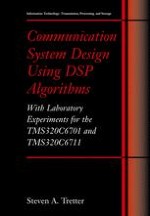2003 | Buch
Communication System Design Using DSP Algorithms
With Laboratory Experiments for the TMS320C6701 and TMS320C6711
verfasst von: Steven A. Tretter
Verlag: Springer US
Buchreihe : Information Technology: Transmission, Processing and Storage
Enthalten in: Professional Book Archive
